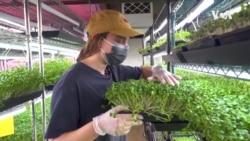((PKG)) URBAN AGRICULTURE
((TRT: 04:10))
((Topic Banner: Urban Agriculture))
((Producer/Camera/Editor: Jeff Swicord))
((Map: Washington D.C.))
((Main characters: 1 female))
((BLURB: As climate change takes its toll on food production in many parts of the world, urban agriculture, growing food indoors under controlled conditions, is taking root as a viable alternative in cities across the U.S.))
((MUSIC/NATS))
((Oksana Bihun
Vice President of Operations, Little Wild Things City Farm))
I initially got into the world of urban agriculture when I was still a college student. Greenhouse growing and student farming. By my senior year, I finally realized that that is, you know, kind of where my pole was.
((NATS))
((Oksana Bihun
Vice President of Operations, Little Wild Things City Farm))
I found myself in New York City initially, so I worked for a company there that did a lot of consulting with urban agriculture around the world. And I just really wanted to get my hands dirty and get a real feel for what a farm does and how it can be improved. And so, that's how I found my way to Little Wild Things Farm. And here I am, managing the farm.
((Oksana Bihun
Vice President of Operations, Little Wild Things City Farm))
We have about 4000 square feet [372 sq. meters] of space. We grow microgreens, lettuces, edible flowers, both in soil-based agriculture and also in hydroponics. So, we grow about 25 to 30 different varieties at the farm.
So, this is some radish. It's a little bit larger than, you know, what you might expect out of a microgreen, but it really has that strong radish taste in it. We've also got some, you know, delicate herbs. So, we have celery over here. You can see, has that traditional celery leaf sticking out of it. We also have some basil. So, this is Purple Opal Basil. It's a little bit sweeter than what you might expect out of traditional Genovese Basil. And so, you can see, it has like that nice purple color in it. And then our other kind is our brassicas.
So, that's anything from broccoli, kale, red cabbage, turnip, kohlrabi. And so, those are kind of our bread and butter here at the farm.
((NATS))
((Oksana Bihun
Vice President of Operations, Little Wild Things City Farm))
Our farm is certified naturally grown, which is very similar to the organic certification. So, we use ladybugs at the farm as a natural pest control. So, they just, you know, hang out on the plants that are growing in our hydroponic base, and then, you know, if we ever have pest issues. So, you know, common pests in urban farms are aphids and spider mites, but they do a lot of work to help control that issue.
((NATS))
((Oksana Bihun
Vice President of Operations, Little Wild Things City Farm))
In most urban cities, a lot of your food comes from, you know, several hundred miles away.
There's a huge climate and financial cost to having imported that food. Urban agriculture in major cities is really kind of an exploding industry. Fresh produce is out the door every single week. They will harvest it, you know, as soon as 10 to 14 days later.
((NATS))
There.
((Oksana Bihun
Vice President of Operations, Little Wild Things City Farm))
And so, that turnaround is really a different model entirely when it comes to agriculture, you know. We're able to have a much, much quicker turnaround.
((NATS))
((Oksana Bihun
Vice President of Operations, Little Wild Things City Farm))
So, the market for our products is a bit varied. It's a subscription where people sign on for ten weeks to receive weekly deliveries of our greens. We still do restaurants, chefs, small grocery stores. Sadly, as climate change gets worse, traditional farming is going to have to adapt. And so, because of that, urban agriculture has the opportunity to really step in there and be an alternative method for farming. So, I definitely think that this model is adaptable to all areas of the world.
((NATS/MUSIC))
((Oksana Bihun
Vice President of Operations, Little Wild Things City Farm))
There is profit to be had in this industry. And, you know, we’re proving it. You know, we have multiple employees, full-time employees, part-time employees that have, you know, a stable living doing urban agriculture, which is pretty awesome.
ວັນພະຫັດ, ໒໕ ທັນວາ ໒໐໒໕











